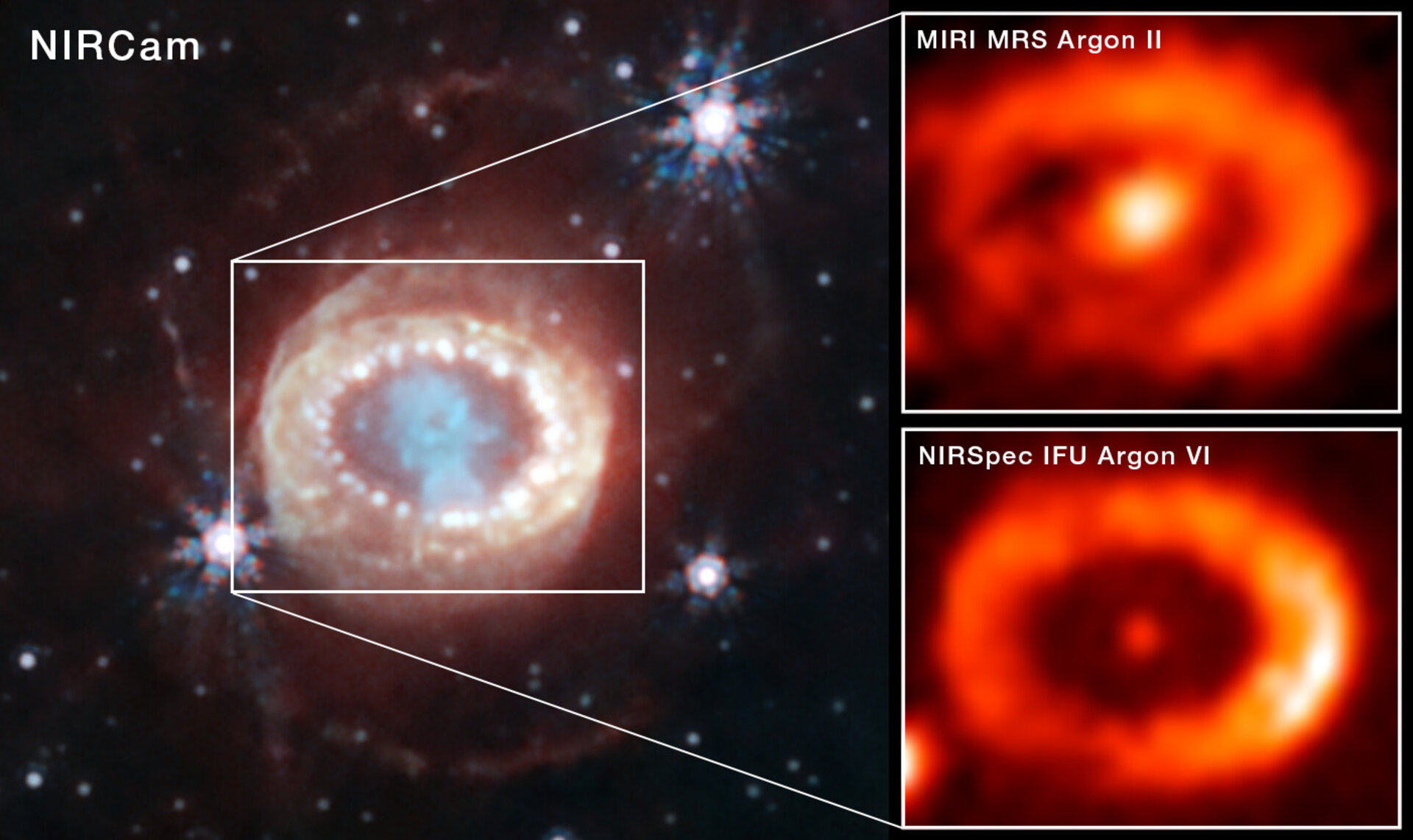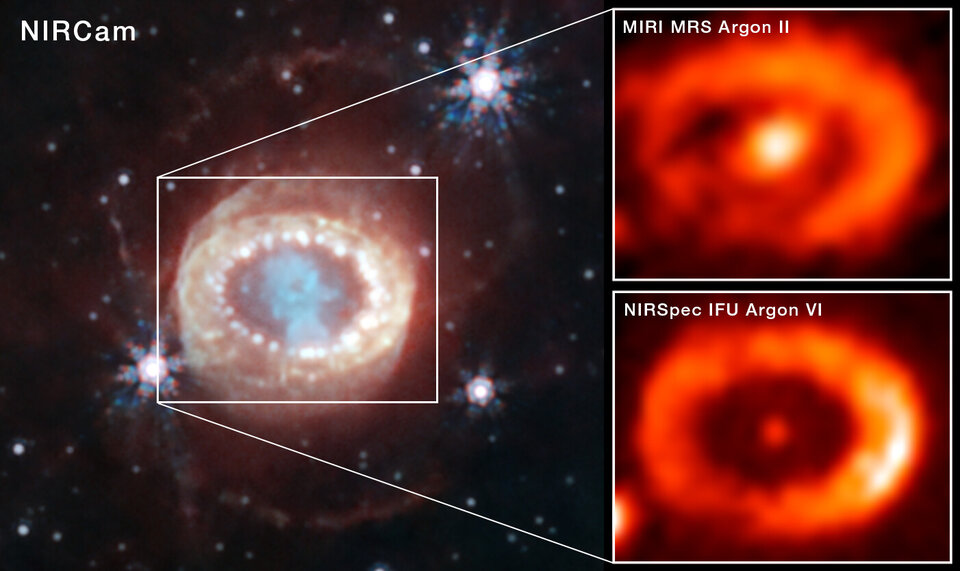Webb finds clues of neutron star at heart of supernova remnant
The NASA/ESA/CSA James Webb Space Telescope has found the best evidence yet for emission from a neutron star at the site of a recently observed supernova. The supernova, known as SN 1987A, occurred 160 000 light-years from Earth in the Large Magellanic Cloud. SN 1987A was observed on Earth in 1987, the first supernova that was visible to the naked eye since 1604 — before the advent of telescopes.
It has offered astronomers a rare opportunity to study the evolution of a supernova and what was left behind, from the very beginning. SN 1987A was a type II, core-collapse, supernova [1], meaning that the compacted remains at its core are expected to have formed either a neutron star or a black hole. Evidence for such a compact object has long been sought. Indications for the presence of a neutron star has previously been found, but this is the first time that the effects of high energy emission from the young neutron star have been detected.
Astronomy typically involves the study of processes that take place over at least tens of thousands of years, far longer than all of human recorded history. Supernovae — the explosive final death throes of some massive stars — blast out within hours, and the brightness of the explosion peaks within a few months. The remains of the exploding star will continue to evolve at a rapid rate over the following decades. Thus, supernovae offer a very rare opportunity to study a key astronomical process in real time.
The supernova SN 1987A was first observed on Earth in February 1987 and its brightness peaked in May that year (although its distance from Earth means that the supernova event actually took place about 160 000 years before). It was the first supernova that could be seen with the naked eye since Kepler's Supernova in 1604.
About two hours prior to the visible light observation of SN 1987A, three observatories around the world saw a burst of neutrinos lasting a few seconds [2]. The neutrino burst shortly before visible light from SN 1987A was linked to the same supernova event. This provided important clues to refine our understanding of core-collapse supernovae, Scientists suspected that this type of supernova would form a neutron star or a black hole.
Astronomers have searched for evidence for one of these compact objects [3] at the centre of the expanding remnant material ever since. Indications for the presence of a neutron star at the centre of the remnant has been found in the past few years. Observations of much older supernova remnants — such as the Crab Nebula — confirm that neutron stars are found in many of these remnants. However, no direct evidence of a neutron star in the aftermath of SN 1987A (or any other such recent supernova explosion) had been observed, until now.
Claes Fransson of Stockholm University, and the lead author on this study, explains: “From theoretical models of SN 1987A, the ten-second burst of neutrinos observed just before the supernova implied that a neutron star or black hole was formed in the explosion. But we have not observed any compelling signature of such a newborn object from any supernova explosion. With Webb, we have now found direct evidence for emission triggered by the newborn compact object, most likely a neutron star.”
Webb began science observations in July 2022, and the observations behind this work were taken on 16 July, making the SN 1987A remnant one the first objects observed by Webb. The team used the Medium Resolution Spectrograph (MRS) mode of Webb’s MIRI instrument, which the members of the same team helped to develop. The MRS is a type of instrument known as an Integral Field Unit (IFU). IFUs are able to image an object and take a spectrum of it at the same time. The instrument captures a spectrum at each pixel, allowing observers to see spectroscopic differences across the object. Spectral analysis of the results showed a strong signal due to ionised argon from the centre of the ejected material that surrounds the original site of SN 1987A.
Subsequent observations using Webb’s NIRSpec (Near Infrared Spectrograph) IFU mode, at shorter wavelengths, more heavily ionised [4] chemical species, including five times ionised argon (meaning argon atoms that have lost five of their 18 electrons). Such ions require highly energetic photons to form, and those photons have to come from somewhere. “To create these ions that we observed in the ejecta, it was clear that there had to be a source of high-energy radiation in the centre of the SN 1987A remnant," Fransson said. "In the paper we discuss different possibilities, finding that only a few scenarios are likely, and all of these involve a newly born neutron star.”
More observations of SN 1987A are planned this year, with Webb and ground-based telescopes. The research team hopes ongoing study will provide more clarity about exactly what is happening in the heart of this supernova remnant. These observations will hopefully spur the development of more detailed models [5], ultimately enabling astronomers to better understand not just SN 1987A, but all core-collapse supernovae.
Notes
[1] Type II supernovae are distinguishable from Type Ia supernovae by the presence of hydrogen in their spectra. They typically result from the core-collapse of a dying massive star with 8–25 times the mass of our Sun. Core-collapse supernovae derive their energy from gravitational potential energy and create and release far more neutrinos than the other mechanism that causes supernovae (nuclear runaway in certain binary star systems). About 99.6 % of the energy is released as neutrinos, while most the rest comes out as kinetic energy and only a tiny fraction as light. Still, they can be as bright as whole galaxy.
[2] Neutrinos are a chargeless type of subatomic particle. They are extremely low in mass (about 500 000 times less massive than an electron). They interact very weakly with other matter, making them extremely challenging to detect. They are produced in abundance in core-collapse supernovae, hence the association between the observed blast of neutrinos and SN 1987A.
[3] Compact objects in astronomy are extremely dense stellar remnants, including white dwarfs, neutron stars and black holes. The core of a neutron star is so dense that a single teaspoon of the neutron material there would weigh over three billion tons.
[4] Ionisation occurs when an atom or a molecule gains or loses electrons, giving it an overall electric charge. This typically happens as a result of either collisions with other particles, or the presence of so-called ionising radiation, such as X-rays and some ultraviolet radiation.
[5] Models are simplified theoretical representations of the behaviour of objects or systems, that allow scientists to predict and explain observations. They might be built on mathematical, chemical and physical principles. In astronomy, as with all sciences, both models and observations are used to develop and refine our understanding of how things work.
More information
Webb is the largest, most powerful telescope ever launched into space. Under an international collaboration agreement, ESA provided the telescope’s launch service, using the Ariane 5 launch vehicle. Working with partners, ESA was responsible for the development and qualification of Ariane 5 adaptations for the Webb mission and for the procurement of the launch service by Arianespace. ESA also provided the workhorse spectrograph NIRSpec and 50% of the mid-infrared instrument MIRI, which was designed and built by a consortium of nationally funded European Institutes (The MIRI European Consortium) in partnership with JPL and the University of Arizona.
Webb is an international partnership between NASA, ESA and the Canadian Space Agency (CSA).
Contact
ESA Media relations
media@esa.int



